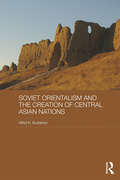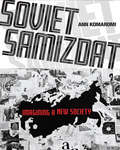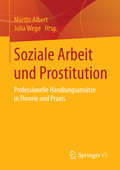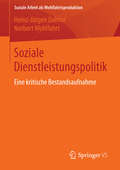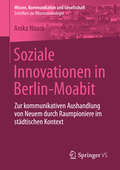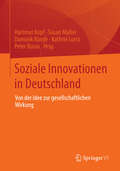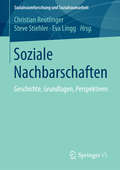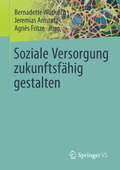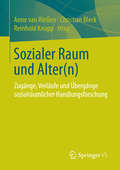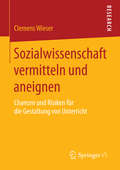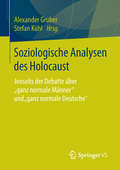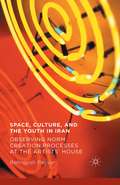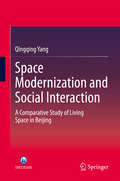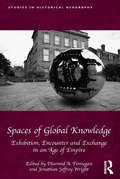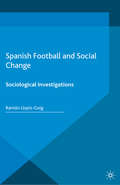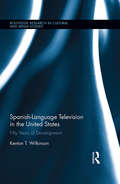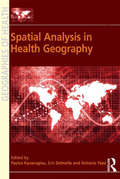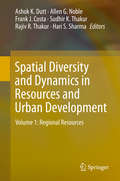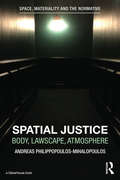- Table View
- List View
Soviet Orientalism and the Creation of Central Asian Nations (Central Asian Studies)
by Alfrid K. BustanovOrientalism – the idea that the standpoint of Western writers on the East greatly affected what they wrote about the East, the "Other" – applied also in Russia and the Soviet Union, where the study of the many exotic peoples incorporated into the Russian Empire, often in quite late imperial times, became a major academic industry, where, as in the West, the standpoint of writers greatly affected what they wrote. Russian/Soviet orientalism had a particularly important impact in Central Asia, where in early Soviet times new republics, later states, were created, often based on the distorted perceptions of scholars in St Petersburg and Moscow, and often cutting across previously existing political and cultural boundaries. The book explores how the Soviet orientalism academic industry influenced the creation of Central Asian nations. It discusses the content of oriental sources and discourses, considers the differences between scholars working in St Petersburg and Moscow and those working more locally in Central Asia, providing a rich picture of academic politics, and shows how academic cultural classification cemented political boundaries, often in unhelpful ways.
Soviet Samizdat: Imagining a New Society (NIU Series in Slavic, East European, and Eurasian Studies)
by Ann KomaromiSoviet Samizdat traces the emergence and development of samizdat, one of the most significant and distinctive phenomena of the late Soviet era, as an uncensored system for making and sharing texts. Based on extensive research of the underground journals, bulletins, art folios and other periodicals produced in the Soviet Union from the mid-1950s to the mid-1980s, Ann Komaromi analyzes the role of samizdat in fostering new forms of imagined community among Soviet citizens. Dissidence has been dismissed as an elite phenomenon or as insignificant because it had little demonstrable impact on the Soviet regime. Komaromi challenges these views and demonstrates that the kind of imagination about self and community made possible by samizdat could be a powerful social force. She explains why participants in samizdat culture so often sought to divide "political" from "cultural" samizdat. Her study provides a controversial umbrella definition for all forms of samizdat in terms of truth-telling, arguing that the act is experienced as transformative by Soviet authors and readers. This argument will challenge scholars in the field to respond to contentions that go against the grain of both anthropological and postmodern accounts. Komaromi's combination of literary analysis, historical research, and sociological theory makes sense of the phenomenon of samizdat for readers today. Soviet Samizdat shows that samizdat was not simply a tool of opposition to a defunct regime. Instead, samizdat fostered informal communities of knowledge that foreshadowed a similar phenomenon of alternative perspectives challenging the authority of institutions around the world today.
Soziale Arbeit und Prostitution: Professionelle Handlungsansätze in Theorie und Praxis
by Martin Albert Julia WegeProstitution stellt einen tabuisierten Randbereich der Gesellschaft dar, über den kaum fundierte Informationen und wissenschaftliche Erkenntnisse vorliegen. Frauen, welche in der Prostitution tätig sind, haben mit gesellschaftlichen Vorurteilen, sozialen Diskriminierungen und rechtlichen Benachteiligungen zu kämpfen und benötigen insofern eine spezifische Beratung und niederschwellige Angebote. Soziale Arbeit weist eine lange Tradition in der Einzelfallhilfe dieser Zielgruppe auf und setzt sich für die Rechte und Würde der Frauen ein. Der Band gibt aus der Sichtweise der professionellen Sozialen Arbeit einen Überblick über die Komplexität des Handlungsfeldes Prostitution und stellt theoretische und methodische Ansätze vor.
Soziale Dienstleistungspolitik: Eine kritische Bestandsaufnahme (Soziale Arbeit als Wohlfahrtsproduktion #6)
by Heinz-Jürgen Dahme Norbert WohlfahrtAusgehend von Liberalisierung und Ökonomisierung sozialer Dienstleistungen werden in dieser Bilanzierung der europäischen und deutschen Dienstleistungspolitik die Folgewirkungen für die Sozialwirtschaft, die Organisationspolitik im Sozialsektor und die Gestaltung von Beschäftigungsbedingungen aufgezeigt. Eine theoretische Standortbestimmung zeigt, dass soziale Dienstleistungspolitik jenseits ihrer Marktöffnung sozialpolitisch bestimmt bleibt.
Soziale Innovationen in Berlin-Moabit: Zur kommunikativen Aushandlung von Neuem durch Raumpioniere im städtischen Kontext (Wissen, Kommunikation und Gesellschaft #0)
by Anika NoackAnika Noack untersucht sozial innovative Handlungsorientierungen der Zivilgesellschaft. Sie geht der Frage nach, inwiefern sich Zivilgesellschaft heute dadurch legitimiert, über Bestehendes und Bekanntes hinauszugehen, oder gar beansprucht, sozial innovativ zu sein. Während die Handlungsorientierung in Richtung Innovation für Ökonomie, Wissenschaft und Forschung bereits langjährig erforscht ist, ist das Forschungsfeld zivilgesellschaftlich initiierter sozialer Innovationen bislang offen geblieben. Am Beispiel von Raumpionieren, die sich auf dem Feld einer sozialen Stadtentwicklungspolitik in Berlin-Moabit engagieren, untersucht die Autorin diese Thematik und fokussiert dabei auf kommunikative Vorgänge zur Erzeugung von sozialen Innovationen.
Soziale Innovationen in Deutschland: Von der Idee zur gesellschaftlichen Wirkung
by Hartmut Kopf Susan Müller Dominik Rüede Kathrin Lurtz Peter RussoFür die Lösung komplexer, gesellschaftlicher Herausforderungen sind soziale Innovationen von enormer Bedeutung. In dem Herausgeberband kommen 18 Sozialinnovatoren zu Wort, deren Lösungen eine der folgenden 5 gesellschaftlichen Herausforderungen adressieren: Langzeitarbeitslosigkeit, Bildungsgerechtigkeit, Ressourcenverbrauch, Zivilisationskrankheiten und Fachkräftemangel. Die Sozialinnovatoren erklären anschaulich, wie ihre sozialen Innovationen funktionieren. Der Herausgeberband soll das Thema „Soziale Innovation“ bekannter machen und als Wissensquelle für (zukünftige) Sozialinnovatoren dienen. Entstanden ist dieser Herausgeberband im Rahmen des vom Bundesministerium für Bildung und Forschung geförderten Forschungsprojektes „Soziale Innovationen in Deutschland“.
Soziale Nachbarschaften: Geschichte, Grundlagen, Perspektiven (Sozialraumforschung und Sozialraumarbeit #10)
by Christian Reutlinger Steve Stiehler Eva LinggAktuelle Siedlungsstrukturen führen zu neuen, vielfältigen Formen von Sozialen Nachbarschaften. Diese entsprechen immer weniger dem Image des anonymen Nebeneinanders, noch dem Bild der engen zwischenmenschlichen Beziehungen auf dem Land. Veränderte Mobilitäts- und Vernetzungsmöglichkeiten tragen außerdem dazu bei, dass bedeutsame persönliche Beziehungen immer weniger ausschließlich in der unmittelbaren (räumlichen) Nachbarschaft verortet sind und das Netz persönlicher (Nachbarschafts-) Beziehungen räumlich weit aufgespannt ist. Gleichzeitig wird dem lokalen Nahraum - im Sinne der baulichen Nachbarschaft - nach wie vor eine hohe Bedeutung zugeschrieben. Das Buch macht sich auf die Spurensuche nach Nachbarschaftskonzepten und -geschichte, ordnet diese in aktuelle theoretische Vergemeinschaftungsdiskurse ein und eröffnet mit dem Konzept der Sozialen Nachbarschaften Perspektiven für Nachbarschaftspolitiken und die professionelle Arbeit mit bzw. in Nachbarschaften.
Soziale Versorgung zukunftsfähig gestalten
by Bernadette Wüthrich Jeremias Amstutz Agnès FritzeSoziale Versorgung hat zum Gegenstand, Leistungen für hilfebedürftige Menschen in einem Gemeinwesen zur Verfügung zu stellen – oder anders: soziale Probleme umfassend zu lösen. Ihre Gestaltung ist eng verknüpft mit verschiedenen gesellschaftlichen Funktionssystemen und erfordert die Sozialpolitik, die Steuerung von und zwischen Organisationen sowie das methodische Handeln differenziert in den Blick zu nehmen. Die Publikation gibt einen Überblick über die aktuelle Diskussion zu sozialer Versorgung im deutschsprachigen Raum. Theoretische Entwicklungen, Forschungsergebnisse und praktische Anwendungen werden dabei gleichermaßen berücksichtigt. Sie bietet damit länderübergreifende Vergleichsmöglichkeiten und Impulse für eine zukunftsfähige Gestaltung von Versorgung.
Sozialer Raum und Alter(n): Zugänge, Verläufe und Übergänge sozialräumlicher Handlungsforschung
by Anne Van Rießen Christian Bleck Reinhold KnoppDie zunehmende Alterung der Gesellschaft hat in den vergangenen Jahren dazu geführt, dass sozialräumliche Voraussetzungen und Perspektiven älterer Menschen stärker in den Fokus sozialpolitischer, städtebaulicher und wissenschaftlicher Diskurse gerückt sind. In diesem Sammelband werden die Schwerpunktthemen Sozialer Raum und Alter(n) anhand ausgewählter theoretischer Grundlagen und aktueller Forschungsprojekte – unter den Kategorien Zugänge, Verläufe und Übergänge – dargestellt und kritisch diskutiert.
Sozialwissenschaft vermitteln und aneignen: Chancen und Risiken für die Gestaltung von Unterricht
by Clemens WieserClemens Wieser erforscht im vorliegenden Buch sozialwissenschaftlichen Unterricht, um dessen spezifische Struktur festzumachen und ausgehend davon Möglichkeiten für Unterrichten aufzuzeigen. Er schlüsselt dafür in einem ersten Schritt Konzepte von Unterricht auf und verdeutlicht Perspektiven, mit denen Handeln im Unterricht untersucht werden kann. Im Anschluss wird ein methodologisches Programm entworfen, das die Analyse von Handlungsabfolgen und die Darstellung von Unterrichtsprozessen ermöglicht. Abschließend werden empirische Analysen vorgestellt, die Chancen und Risiken des Vermittelns und Aneignens von Sozialwissenschaft sichtbar machen und das Einlassen auf Unterrichten ermöglichen.
Soziologische Analysen des Holocaust: Jenseits der Debatte über "ganz normale Männer" und "ganz normale Deutsche“
by Alexander Gruber Stefan KühlDie Autoren dieses Bandes entwickeln am Beispiel des Hamburger Reserve-Polizeibataillons 101 soziologische Perspektiven auf die Beteiligung der Ordnungspolizisten am Holocaust. In den Beiträgen geht es nicht vorrangig darum, bislang unbekannte beziehungsweise in Vergessenheit geratene historische Sachverhalte darzustellen, sondern neue soziologische Perspektiven auf historisch bereits erschlossene Sachverhalte zu entwickeln. Die Autoren leisten damit Beiträge für eine soziologische Analyse des Holocaust, die sich von den dominierenden Analysen der Geschichtswissenschaft durch ihre theoretische Perspektive unterscheiden.
Space, Culture, and the Youth in Iran: Observing Norm Creation Processes at the Artists’ House
by Behnoosh PayvarThis book analyzes the Artists' House, a cultural center in Tehran, to place Iran's social and cultural transformation in a local-global context. The text addresses the interaction of Iranian youth with technology and mass communications, law, tradition, and contemporary questions concerning body, identity, and lifestyle.
Space Modernization and Social Interaction: A Comparative Study of Living Space in Beijing (China Academic Library)
by Qingqing YangThis book concerns the Beijing Hutong and changing perceptions of space, of social relations and of self, as processes of urban redevelopment remove Hutong dwellers from their traditional homes to new high-rise apartments. It addresses questions of how space is humanly built and transformed, classified and differentiated, and most importantly how space is perceived and experienced. This study elaborates and expands Lefebvre’s “trialectic” of space on a theoretical level. The ethnography presented is a conversation with Tim Ingold’s argument about “empty space”. This research employs the ethnographic technique of participant-observation to secure a finely textured, detailed and micro-social account of local experience. Then, these micro-social insights are contextualized within macro-social structures of Chinese modernism by speaking to geographical concerns, orientalism and history.
Space Unveiled: Invisible Cultures in the Design Studio (Routledge Research in Architecture)
by Carla Jackson BellSince the early 1800s, African Americans have designed signature buildings; however, in the mainstream marketplace, African American architects, especially women, have remained invisible in architecture history, theory and practice. Traditional architecture design studio education has been based on the historical models of the Beaux-Arts and the Bauhaus, with a split between design and production teaching. As the result of current teaching models, African American architects tend to work on the production or technical side of building rather than in the design studio. It is essential to understand the centrality of culture, gender, space and knowledge in design studios. Space Unveiled is a significant contribution to the study of architecture education, and the extent to which it has been sensitive to an inclusive cultural perspective. The research shows that this has not been the case in American education because part of the culture remains hidden.
Space Unveiled: Invisible Cultures in the Design Studio (Routledge Research in Architecture)
by Carla Jackson BellSince the early 1800s, African Americans have designed signature buildings; however, in the mainstream marketplace, African American architects, especially women, have remained invisible in architecture history, theory and practice. Traditional architecture design studio education has been based on the historical models of the Beaux-Arts and the Bauhaus, with a split between design and production teaching. As the result of current teaching models, African American architects tend to work on the production or technical side of building rather than in the design studio. It is essential to understand the centrality of culture, gender, space and knowledge in design studios. Space Unveiled is a significant contribution to the study of architecture education, and the extent to which it has been sensitive to an inclusive cultural perspective. The research shows that this has not been the case in American education because part of the culture remains hidden.
Spaces of Global Knowledge: Exhibition, Encounter and Exchange in an Age of Empire (Studies in Historical Geography)
by Diarmid A. Finnegan Jonathan Jeffrey Wright’Global’ knowledge was constructed, communicated and contested during the long nineteenth century in numerous ways and places. This book focuses on the life-geographies, material practices and varied contributions to knowledge, be they medical or botanical, cartographic or cultural, of actors whose lives crisscrossed an increasingly connected world. Integrating detailed archival research with broader thematic and conceptual reflection, the individual case studies use local specificity to shed light on global structures and processes, revealing the latter to be lived and experienced phenomena rather than abstract historiographical categories. This volume makes an original and compelling contribution to a growing body of scholarship on the global history of knowledge. Given its wide geographic, disciplinary and thematic range this book will appeal to a broad readership including historical geographers and specialists in history of science and medicine, imperial history, museum studies, and book history.
Spaces of Global Knowledge: Exhibition, Encounter and Exchange in an Age of Empire (Studies in Historical Geography)
by Diarmid A. Finnegan Jonathan Jeffrey Wright’Global’ knowledge was constructed, communicated and contested during the long nineteenth century in numerous ways and places. This book focuses on the life-geographies, material practices and varied contributions to knowledge, be they medical or botanical, cartographic or cultural, of actors whose lives crisscrossed an increasingly connected world. Integrating detailed archival research with broader thematic and conceptual reflection, the individual case studies use local specificity to shed light on global structures and processes, revealing the latter to be lived and experienced phenomena rather than abstract historiographical categories. This volume makes an original and compelling contribution to a growing body of scholarship on the global history of knowledge. Given its wide geographic, disciplinary and thematic range this book will appeal to a broad readership including historical geographers and specialists in history of science and medicine, imperial history, museum studies, and book history.
Spanish Football and Social Change: Sociological Investigations (Football Research in an Enlarged Europe)
by R. Llopis-GoigIn the past few decades, Spanish football has undergone a significant transformation, both on and off the pitch. Llopis-Goig analyses these trends, questioning the role of football in contemporary Spanish society and examining the historical reasons for its social hegemony.
Spanish-Language Television in the United States: Fifty Years of Development (Routledge Research in Cultural and Media Studies)
by Kenton T. WilkinsonSince its introduction in the early 1960s, Spanish-language television in the United States has grown in step with the Hispanic population. Industry and demographic projections forecast rising influence through the 21st century. This book traces U.S. Spanish-language television’s development from the 1960s to 2013, illustrating how business, regulation, politics, demographics and technological change have interwoven during a half century of remarkable change for electronic media. Spanish-language media play key social, political and economic roles in U.S. society, connecting many Hispanics to their cultures of origin, each other, and broader U.S. society. Yet despite the population’s increasing impact on U.S. culture, in elections and through an estimated $1.3 trillion in spending power in 2014, this is the first comprehensive academic source dedicated to the medium and its history. The book combines information drawn from the business press and trade journals with industry reports and academic research to provide a balanced perspective on the origins, maturation and accelerated growth of a significant ethnic-oriented medium.
Spanish-Language Television in the United States: Fifty Years of Development (Routledge Research in Cultural and Media Studies)
by Kenton T. WilkinsonSince its introduction in the early 1960s, Spanish-language television in the United States has grown in step with the Hispanic population. Industry and demographic projections forecast rising influence through the 21st century. This book traces U.S. Spanish-language television’s development from the 1960s to 2013, illustrating how business, regulation, politics, demographics and technological change have interwoven during a half century of remarkable change for electronic media. Spanish-language media play key social, political and economic roles in U.S. society, connecting many Hispanics to their cultures of origin, each other, and broader U.S. society. Yet despite the population’s increasing impact on U.S. culture, in elections and through an estimated $1.3 trillion in spending power in 2014, this is the first comprehensive academic source dedicated to the medium and its history. The book combines information drawn from the business press and trade journals with industry reports and academic research to provide a balanced perspective on the origins, maturation and accelerated growth of a significant ethnic-oriented medium.
Spatial Analysis in Health Geography (Geographies of Health Series)
by Pavlos Kanaroglou Eric DelmellePresenting current research on spatial epidemiology, this book covers topics such as exposure, chronic disease, infectious disease, accessibility to health care settings and new methods in Geographical Information Science and Systems. For epidemiologists, and for the management and administration of health care settings, it is critical to understand the spatial dynamics of disease. For instance, it is crucial that hospital administrators develop an understanding of the flow of patients over time, especially during an outbreak of a particular disease, so they can plan for appropriate levels of staffing and to carry out adaptive prevention measures. Furthermore, understanding where and why a disease occurs at a certain geographic location is vital for decision makers to formulate policy to increase the accessibility to health services (either by prevention, or adding new facilities). Spatial epidemiology relies increasingly on new methodologies, such as clustering algorithms, visualization and space-time modelling, the domain of Geographic Information Science. Implementation of those techniques appears at an increasing pace in commercial Geographic Information Systems, alongside more traditional techniques that are already part of such systems. This book provides the latest methods in GI Science and their use in health related problems.
Spatial Analysis in Health Geography (Geographies of Health Series)
by Pavlos Kanaroglou Eric DelmellePresenting current research on spatial epidemiology, this book covers topics such as exposure, chronic disease, infectious disease, accessibility to health care settings and new methods in Geographical Information Science and Systems. For epidemiologists, and for the management and administration of health care settings, it is critical to understand the spatial dynamics of disease. For instance, it is crucial that hospital administrators develop an understanding of the flow of patients over time, especially during an outbreak of a particular disease, so they can plan for appropriate levels of staffing and to carry out adaptive prevention measures. Furthermore, understanding where and why a disease occurs at a certain geographic location is vital for decision makers to formulate policy to increase the accessibility to health services (either by prevention, or adding new facilities). Spatial epidemiology relies increasingly on new methodologies, such as clustering algorithms, visualization and space-time modelling, the domain of Geographic Information Science. Implementation of those techniques appears at an increasing pace in commercial Geographic Information Systems, alongside more traditional techniques that are already part of such systems. This book provides the latest methods in GI Science and their use in health related problems.
Spatial Diversity and Dynamics in Resources and Urban Development: Volume 1: Regional Resources
by Ashok K. Dutt Allen G. Noble Frank J. Costa Sudhir K. Thakur Rajiv Thakur Hari S. SharmaThis double-volume work focuses on socio-demographics and the use of such data to support strategic resource management and planning initiatives. Papers go beyond explanations of methods, technique and traditional applications to explore new intersections in the dynamic relationship between the utilization and management of resources, and urban development.International authors explore numerous experiences, characteristics of development and decision-making influences from across Asia and Southeast Asia, as well as recounting examples from America and Africa. Papers propound techniques and methods used in geographical research such as support vector machines, socio-economic correlates and travel behaviour analysis.In this volume the contributions examine issues such as natural resource and environmental management, livelihoods issues in the context of climate change, land markets and land trusts, adaptive management of wildlife sanctuaries, ground water scarcity, flood hazards and flood plain management, non-conventional energy resources, community forestry and management and land use and land cover change. The significance of these topics lie in the pace and volume of change as is reflected through continued development within established fields of inquiry and the introduction of significantly new approaches during the last decade.Readers are invited to consider the dynamics of spatial expansion of urban areas and economic development, and to explore conceptual discussion of the innovations in and challenges on urbanization processes, urban spaces themselves and both resource management and environmental management.Together, the two volumes contribute to the interdisciplinary literature on regional resources and urban development by collating recent research with geography at its core. Scholars of urban geography, human geography, urbanism and sustainable development will be particularly interested in this book.
Spatial Justice: Body, Lawscape, Atmosphere
by Andreas Philippopoulos-MihalopoulosThere can be no justice that is not spatial. Against a recent tendency to despatialise law, matter, bodies and even space itself, this book insists on spatialising them, arguing that there can be neither law nor justice that are not articulated through and in space. Spatial Justice presents a new theory and a radical application of the material connection between space – in the geographical as well as sociological and philosophical sense – and the law – in the broadest sense that includes written and oral law, but also embodied social and political norms. More specifically, it argues that spatial justice is the struggle of various bodies – human, natural, non-organic, technological – to occupy a certain space at a certain time. Seen in this way, spatial justice is the most radical offspring of the spatial turn, since, as this book demonstrates, spatial justice can be found in the core of most contemporary legal and political issues – issues such as geopolitical conflicts, environmental issues, animality, colonisation, droning, the cyberspace and so on. In order to ague this, the book employs the lawscape, as the tautology between law and space, and the concept of atmosphere in its geological, political, aesthetic, legal and biological dimension. Written by a leading theorist in the area, Spatial Justice: Body, Lawscape, Atmosphere forges a new interdisciplinary understanding of space and law, while offering a fresh approach to current geopolitical, spatiolegal and ecological issues.
Spatial Justice: Body, Lawscape, Atmosphere
by Andreas Philippopoulos-MihalopoulosThere can be no justice that is not spatial. Against a recent tendency to despatialise law, matter, bodies and even space itself, this book insists on spatialising them, arguing that there can be neither law nor justice that are not articulated through and in space. Spatial Justice presents a new theory and a radical application of the material connection between space – in the geographical as well as sociological and philosophical sense – and the law – in the broadest sense that includes written and oral law, but also embodied social and political norms. More specifically, it argues that spatial justice is the struggle of various bodies – human, natural, non-organic, technological – to occupy a certain space at a certain time. Seen in this way, spatial justice is the most radical offspring of the spatial turn, since, as this book demonstrates, spatial justice can be found in the core of most contemporary legal and political issues – issues such as geopolitical conflicts, environmental issues, animality, colonisation, droning, the cyberspace and so on. In order to ague this, the book employs the lawscape, as the tautology between law and space, and the concept of atmosphere in its geological, political, aesthetic, legal and biological dimension. Written by a leading theorist in the area, Spatial Justice: Body, Lawscape, Atmosphere forges a new interdisciplinary understanding of space and law, while offering a fresh approach to current geopolitical, spatiolegal and ecological issues.
